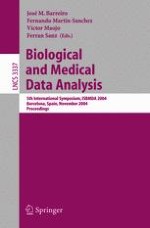2004 | Buch
Biological and Medical Data Analysis
5th International Symposium, ISBMDA 2004, Barcelona, Spain, November 18-19, 2004. Proceedings
herausgegeben von: José María Barreiro, Fernando Martín-Sánchez, Víctor Maojo, Ferran Sanz
Verlag: Springer Berlin Heidelberg
Buchreihe : Lecture Notes in Computer Science
Enthalten in: Professional Book Archive
